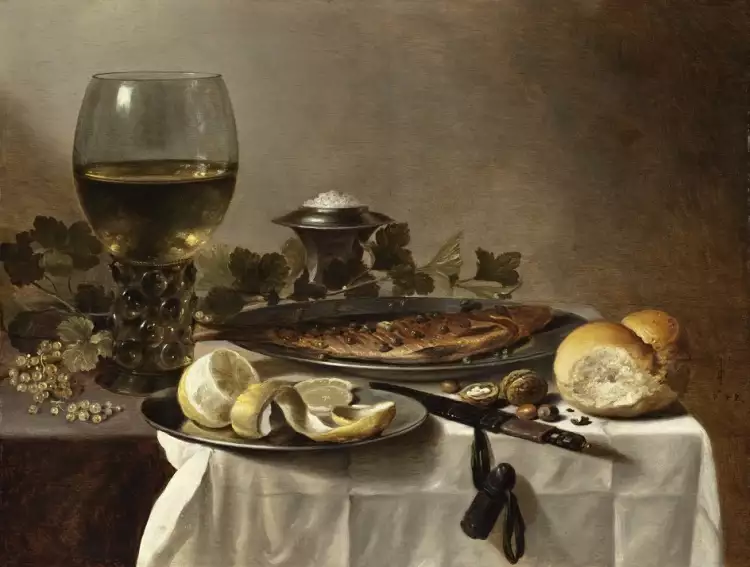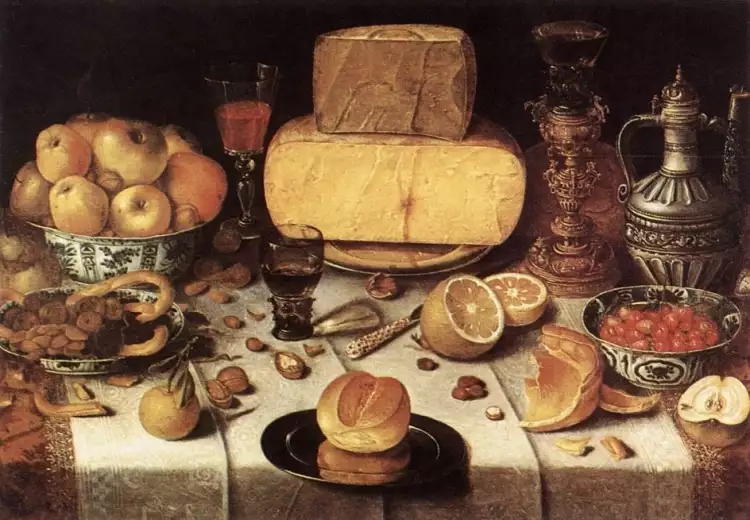
Still life is a genre of painting that perfectly reflects the artist's inner universe
Still life is a genre of visual art in which ordinary objects are the main characters of the work. These objects can be not only inanimate but also living creatures. However, birds, animals, or people in a still life play a secondary role, merely complementing the main motif of the painting.
 Still life. Jan Chrucki. Fruit, 1834
Still life. Jan Chrucki. Fruit, 1834
The term "nature morte" is literally translated from French as "dead nature." Experienced art connoisseurs also know another English name for the genre - "Still Life." There is a common belief that it is in still lifes and landscapes that an artist's inner world is best revealed. Brilliant masters make viewers admire copies of simple things that people don't pay any attention to in everyday life.
History of Still Life
Still life emerged as a separate genre of painting only in the 17th century, but people have been depicting objects around them on paintings and walls for a long time. In the temples and tombs of Ancient Egypt, among the scenes of offering gifts to the gods, easily recognizable inanimate objects are often found. Unknown artists did not try to depict them in maximum realism but aimed to clearly emphasize the importance of each painted object.
 Still life. Ancient Rome. Wall mosaic
Still life. Ancient Rome. Wall mosaic
On surviving wall paintings and mosaics of ancient masters, inanimate objects are depicted in more detail. Artists of Ancient Rome and Greece learned to skillfully depict different shades of objects in their creations, but the subjects with ordinary objects had exclusively decorative value at that time. Images of flowers, fruits, or animals were used to decorate individual elements of the interior in homes (niches, walls of residential and public buildings).
In the 15th and 16th centuries, still life was not yet considered by artists as a full-fledged genre of easel painting. Ordinary things were only a part (and a secondary one) of the overall composition of a work on historical or religious themes. Separate depictions of inanimate objects were used solely for the decorative design of the home environment or furniture.
 Still life. Willem van Aelst. Dead Birds and hunting equipment, 1660
Still life. Willem van Aelst. Dead Birds and hunting equipment, 1660
However, in the 17th century, still life painting became a full-fledged genre of art. This happened in the largest trading center of Northern Europe - the Netherlands. The famous "Dutch masters" played a significant role in this event. The following masters of easel painting turned to this theme more often than others:
- Pieter Claesz.
- Willem Claesz (Claeszoon) Heda.
- Willem Kalf.
- Balthasar van der Ast.
- Willem van Aelst.
- Jan van Huysum.
Main Subgenres of Still Life
During that time in the Netherlands, there was fierce competition in the art market. Artists aimed to hone their craftsmanship to perfection and often consciously chose narrow themes for their works. It was then that the main subgenres of still life emerged:
- Floral. Depicted the Dutch people's mass enthusiasm for horticulture.
- Tonal. Most paintings were executed in muted tones with a predominance of gray and brown colors.
- Kitchen. Many works in this subgenre featured scenes from people's everyday lives in addition to inanimate objects.
- Fish. This specialization paid tribute to the brave sailors and fishermen of the Netherlands.
- Luxury. Reflected the bourgeoisie's pursuit of wealth and luxury.
- Hunting. Paintings depicting game were popular among wealthy local bourgeois hunters.
- Flower and Fruit. The peak of popularity for this subgenre came in the second half of the 17th century.
- Banquets and Breakfasts. Traditional national foods and delicacies were depicted on canvases.
- Vanitas. Paintings in this subgenre always included objects reminding viewers of the transience of human life (skull, candle, withered flowers, or rotting fruit).
- Trompe-l'œil. Created the illusion of three-dimensionality, making it extremely difficult to distinguish painted objects from real ones.
 Still life. Pieter Claesz. Still Life with Fish, Wine and Bread
Still life. Pieter Claesz. Still Life with Fish, Wine and Bread
Broad opportunities for innovative reinterpretation of still life emerged in the late 19th to early 20th century. Outstanding masters of various new styles were not afraid to conduct bold experiments. The greatest artists of that time turned to still life themes, including Paul Cézanne, Paul Gauguin, and Henri Matisse. The genre is present to varying degrees in the works of many art movements:
- Impressionism.
- Cubism.
- Surrealism.
- Abstract art.
- Expressionism.
- Fauvism.
After World War II, still life gracefully found its way into new art styles: pop art, photorealism, and neo-pop. This genre certainly has a future in the 21st century that has just begun.
Famous Masters of Still Life
Simply listing all the artists who made a significant contribution to the formation and development of the still life genre would take several pages. Among the "Dutch masters" alone, you can find two to three dozen artists well-known to a wide circle of art enthusiasts. The author of this article apologizes in advance to the reader for having to limit the description in this section to a tiny fraction of worthy representatives of the genre:
- Jan Brueghel the Elder. One of the pioneers of the genre. This great master repeatedly traveled a distance of 45 kilometers from Antwerp to Brussels to find and sketch various flowers in the local botanical garden for his future paintings.
- Floris van Dyck. Only four works by the author have survived to this day, all painted in the subgenre of the laid table. A pyramid of cheese pieces takes a central place in all the paintings, while the background skillfully dissolves into a haze.
- Abraham van Beyeren. Acknowledged by art experts as the best artist in the subgenre of fish still life. The master's naturalistic paintings amaze with their perfect detailed rendering of fish scales in a silvery-gray palette.
- Jacob de Heem the Younger. The brushes of this painter created the earliest work in the subgenre Vanitas, created in the distant year 1603. This painting has been reminding viewers of the transience of human life for over 400 years.
- Vincent van Gogh. Paintings from the "Sunflowers" series by the brilliant post-impressionist now adorn the exhibitions of the world's best museums. Among them are the Philadelphia Museum of Art and the Metropolitan Museum (USA), the New Pinakothek in Munich (Germany), and the National Gallery in London (UK).
- Salvador Dalí. The greatest surrealist of all time also made his contribution to the genre's development. His sculptural composition "Lobster Telephone" vividly symbolizes the master's protest against people's worship of technology, making us reflect on the importance of simple human relationships.
- Pablo Picasso. The "most expensive" cubist in the world turned to the theme at various stages of his career, from his early period to his later works. His works are easily recognizable and unique.
- Andy Warhol. His globally renowned "Campbell's Soup Cans" in 1962 became a vibrant presentation of a new direction in art, pop art, to the whole world.
 Still life. Jan Brueghel the Elder. Flowers in a Wooden Vessel, 1603
Still life. Jan Brueghel the Elder. Flowers in a Wooden Vessel, 1603
 Still life. Floris van Dyck. Still Life with Cheese
Still life. Floris van Dyck. Still Life with Cheese
 Still life. Abraham van Beyeren. Still Life with Fish
Still life. Abraham van Beyeren. Still Life with Fish
 Still life. Jacob de Heem the Younger. Vanitas
Still life. Jacob de Heem the Younger. Vanitas
 Still life. Vincent van Gogh. Sunflowers, 1887-1889
Still life. Vincent van Gogh. Sunflowers, 1887-1889
 Still life. Salvador Dalí. Lobster Telephone, 1936
Still life. Salvador Dalí. Lobster Telephone, 1936
 Still life. Pablo Picasso. Still life with a black bull's head, 1938
Still life. Pablo Picasso. Still life with a black bull's head, 1938
 Still life. Andy Warhol. Campbell's Soup, 1968
Still life. Andy Warhol. Campbell's Soup, 1968
Over many years of human history, still life has experienced ups and downs. This genre has a fascinating past, a vibrant present, and a promising future in the world of visual art. Visitors to the Very Important Lot portal's auctions can always find paintings on any theme. Additionally, on our website, you can purchase paintings directly from contemporary artists and become the proud owner of works by masters from different eras and styles.
 Paul Mathias Padua: Sensitive power nature
Paul Mathias Padua: Sensitive power nature  Numismatics is a serious scientific discipline or enthusiastic collection of ancient coins
Numismatics is a serious scientific discipline or enthusiastic collection of ancient coins  Marquetry is the elegant ancient art of inlaying veneer
Marquetry is the elegant ancient art of inlaying veneer  The Timeless Charm of Vintage Ephemera: A Collector's Guide
The Timeless Charm of Vintage Ephemera: A Collector's Guide  Pre-Raphaelites - the romantics of Victorian England
Pre-Raphaelites - the romantics of Victorian England  The painting "The Jewish Bride" by Rembrandt is one of the master's last works
The painting "The Jewish Bride" by Rembrandt is one of the master's last works  Order of Carlos III is the highest civilian award in Spain
Order of Carlos III is the highest civilian award in Spain  The Rising Trend of Collecting Regional Books in the Antiques Market
The Rising Trend of Collecting Regional Books in the Antiques Market  Silver of Great Britain - History, Styles, and Hallmarks
Silver of Great Britain - History, Styles, and Hallmarks  Luxury Cars at Monterey Auctions: A Showcase of Iconic Vehicles
Luxury Cars at Monterey Auctions: A Showcase of Iconic Vehicles